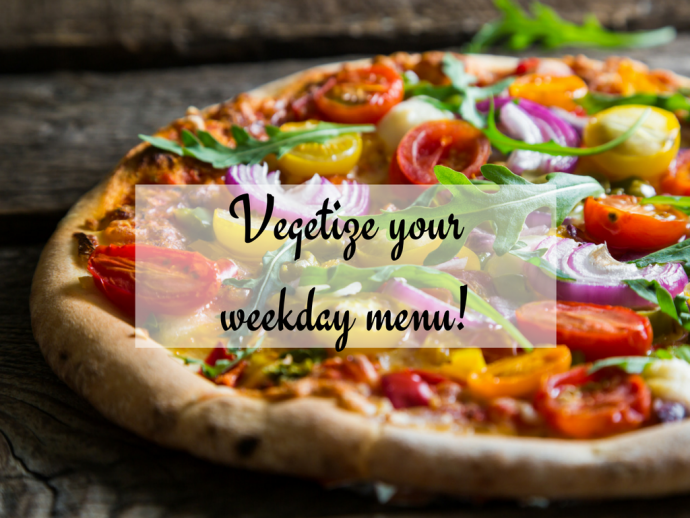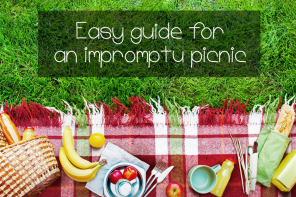Who hasn’t made a New Year’s resolution for their diet? You say you’ll get more exercise, cut out certain foods, eat more fruits and veggies, follow a healthier diet… but it all seems so overwhelming, even undoable.
Sometimes all you need is a little nudge to help you get back on track food-wise. Instead of changing everything about your diet overnight, start with a simple step: add veggies to your favourite dishes!
In order to help you eat more veggies every day, we have a few tips and tricks to “vegetize” some of your weekday meals. Bon appétit!
A good burger!

When you think burgers, you often think of a little lettuce, a few tomatoes and some cheese, but how can you make this North American classic healthier? By adding new textures and flavours with veggies!
Toppings: add a little crunch!
Sliced root vegetables like carrots, parsnips and beets are excellent in burgers. They’re a little sweet, can be piled nicely on top of a burger and add a nice colour to the presentation!
Lettuce is good in burgers too, but why stop at iceberg? Try arugula and spinach. As well as having a stronger taste, they contain a good amount of iron and calcium!
You can also get into the habit of adding avocado. It’s rich and creamy and whether you slice or add it as guacamole, it’s elevates any hamburger.
Restaurants often offer coleslaw as a side for burgers, but times have changed! Put coleslaw directly on the burger itself. As well as being low fat, cabbage is a good source of fibre, vitamin C and calcium! Coleslaw even keeps burgers moist which just makes every bite even more juicy!
Meatballs: Get off the beaten track!
Finding alternative solutions to your favourite meals can require changing the basics. Who says that meatballs have to made from meat? Meatballs made from veggies or legumes have less fat, are more affordable and are more easily digested. In fact, many restaurants now offer Portobello mushrooms disguised as meatballs. The mushroom’s texture keeps it moist and its shape works really well in a bun. Just season, grill and voilà! You’ve got yourself a meaty meatless burger!
Another innovative way to replace the traditional meatball is to use slices of eggplant. Simply cut thick slices, dip them in beaten egg, then coat well with breadcrumbs. Cook them in oil until both sides are lightly golden and there you go – a delicious, new kind of burger!
Want to hide veggies in a meatball? Just finely chop some zucchini and carrots, for example, and put them in your ground meat mixture. It’s a great way to add a little crunch to your meatballs, as well as a discreet dose of vitamins.
And where are the legumes in all this? There are hundreds of vegetarian meatball recipes in books and online, but which ones do we recommend?
-chick peas
-red kidney beans
-black beans
-pinto beans
-lentils
Drain canned legumes or rehydrate dry ones. Reduce to a purée and season with your favourite combination of herbs and spices. Be creative and incorporate finely chopped legumes into your mixtures. Finally, add a little flour or oatmeal so the meatballs hold together for grilling.
Try these homemade veggie burger recipes:
Black Bean & Quinoa Veggie Burger
Pizza: an Italian delight revisited!

Now who doesn’t like pizza? It’s easy, you can get it in many grocery stores or simply have it delivered – but why not just make it yourself with a little veggie touch? Fruits and veggies – it’s a date!
Fully-loaded combo!
Create new flavour combos by adding unusual toppings to your pizza. The only limit is your imagination! Enhance with veggies that are simple, nutritious and oh-so yum! We’ve put together a list of fruits and veggies for you to try.
Corn
Whether frozen or canned, corn is the special ingredient to top any pizza. In addition to adding colour, corn contains vitamins B and C, fibre and a lot of minerals, such as phosphorus, potassium and magnesium. Just add before popping the pizza into the oven. The kernels will grill and give a nice, light taste to your dish!
Eggplant
Eggplant has the fewest calories of all veggies because it’s got a high water content, but also provides a lot of nutritional value. In fact, it has tons of potassium and vitamin B9. To incorporate into your pizza, slice and grill for a few minutes under the broiler to help remove water from its flesh. Place grilled eggplant slices on top of your pizza which goes great with tomato sauce, by the way.
Pear
If you’re looking for out-of-the-ordinary flavours, think about putting fresh pear on your next pizza. The pear’s sweetness goes well with salty cheese and cold cuts like pancetta and prosciutto. And if you want something that’s rich in fibre and antioxidants, you can’t go wrong with pear as a topping!
Squash
Antioxidants, magnesium, potassium, vitamin A, B9 and C – this is what you add to your pizza if you top with winter squashes like butternut, delicate or pepper squash which are simple to cook and can be prepared in many ways. To prepare squash for pizza, reduce it to a purée and use as a sauce or cube and grill it beforehand. Squash will add a delicate flavour to your pizza while being nutritious. Try it on pizza with cheddar, blue or goat cheese.
Root vegetables
One of the advantages of root vegetables is that they’re versatile. You can put them in soups, purées, en papillote and now on pizza! Carrots, turnips, potatoes and sweet potato are all great options for pizza. Grill your favourite root veggie so that they’re already tender when you put them on the pizza. They go great with rosemary, ricotta and mozzarella.
Original pizza sauce with tons of veggies!
When it comes time to including veggies on a pizza, the secret is in the sauce! If you want to avoid store-bought sauces and make your own, think about adding as many veggies as possible. Beets, carrots, mushrooms, cauliflower, zucchini, sweet potato and peppers are all good additions for your usual tomato sauce. As well as increasing the nutritional value of your dish, it’ll add a lot of flavour and colour to your pizza!
Pizza – without a dough?
Veggies give you many easy and inexpensive alternatives to make a crustless pizza. As well as being good for the pocketbook, this trend will help you discover innovative ways to incorporate veggies into your eating habits. We’ve put together a list of interesting ideas to replace the classic pizza dough.
-broccoli
-cauliflower
-sweet potato
-parsnip
-zucchini
These veggies are the easiest to adapt to pizza dough. Just process the veggies you want to use in the food processor or grate them in small pieces. Mix with spices, egg and cheese if you want. Spread onto a baking sheet to form a pizza crust and cook until the edges are lightly golden. Take the cooked crust out of the oven and top the pizza with whatever your heart desires. Return to the oven and cook until the cheese is melted.
Vegetized fries!

There’s no doubt about it – fries are to die for! Whether you love them with ketchup or mayo, it’s hard to resist the famous French fry. But we all know that it’s hardly the healthiest food option. That’s why we suggest more vegetized choices disguised as fries that will satisfy your occasional fried needs and be the perfect side to your meals!
Asparagus
Source of vitamins A, B9 and C, asparagus is a veggie that can be prepared as a fry because of its shape. To make fried asparagus without using too much oil, mix Panko breadcrumbs and parmesan together. Bake for about 12 minutes or until they’re crunchy. A real treat!
Avocado
Crunchy on the outside, tender and creamy on the inside, fried avocado is just divine! Avocado is a fruit that has several vitamins and is one of the rare fruits that contains unsaturated fats which is a good source of fat. To prepare avocado properly, dip avocado slices in beaten egg, coat with breadcrumbs and bake in the oven!
Carrots
Simple and delicious, fried carrots are a healthier option. They have fewer carbohydrates than potatoes and are chockful of vitamin A, calcium, potassium and fibre and carotenoids, a type of antioxidant. Sliced or julienned, fried carrots are an super substitute for regular fries!
Parsnip
Fried parsnip? Their sweet taste will surprise your taste buds! Actually, parsnip has twice as many carbohydrates as carrots and are a good source of vitamin K. Cut them into sticks and bake them in the oven with a little olive oil. Enjoy with aioli or spicy mayo!
Zucchini
A veritable all-purpose veggie, zucchini is excellent as a fry. They contain a lot of water, so have to be cooked longer than French fries so they’re nice and crunchy, not limp. To prepare them, just slice into rings or sticks, dip in beaten eggs and coat in breadcrumbs. For a real treat, sprinkle with parmesan and rosemary. Serve with chipotle mayo or tomato sauce!
Try these flavourful veggie fries:
Pasta and veggies: presto, done!

A plate of pasta during the week is quick and easy to make. Just boil the pasta, heat the tomato sauce and… add a few veggies? Simple, fast and good. Make your pasta dish delish!
Grilled veggies – yes, please!
Adding veggies to your pasta has never been this easy because everything is done at the same time. Before cooking the pasta, heat the sauce, line a baking sheet with parchment paper and spread out your favourite veggies. Peppers, mushrooms, zucchini, asparagus, eggplant, cauliflower, onions, tomatoes – be creative! Drizzle with olive oil, season with your fave herbs and spices, then bake until it’s time to eat!
Camouflaging veggies
If you want young kids to eat their veggies, sometimes you just have to hide them – and you’ve got to be conniving if that’s the case! A good way to accomplish this is by choosing veggies that have the same colours as the dish you’re making. Why not conceal carrots or butternut squash in a mac and cheese? As well as texture and taste, you’ll enrich your pasta dish with nutritional elements. If you want to learn more about how to get children to eat veggies, check out our article on this topic, which offers simple culinary tips!
Why not change your pasta? There are several veggies on the market that can replace pasta. There’s the famous spaghetti squash and others from the same family like orangetti, stripetti or smallghetti. You can also use zucchini and a spiral peeler to make pasta. Imagination is key to diversifying your recipe box and vegetizing your favourite dishes!
Here are a few tasty vegetized recipes:
Spaghetti squash carbonara au gratin
Snack without stuffing yourself!

What happens when you get snack-ish? Too often, you’re tempted by chips, pretzels, chocolate or granola bars. However, there’s an easy, inexpensive and delicious way to snack – with veggies!
Snacks to fill our hunger
Customizable and really simple to make, roasted chick peas make a great snack. Take two cans of chick peas and rinse them in a colander. Then dry them for about half an hour so that all the water from rinsing is completely gone. In the meantime, preheat the oven to 400 oF (200 oC). Once dry, spread the chick peas onto a baking sheet and bake for 40 to 60 minutes or until crunchy. Remove from the oven and drizzle with olive oil. Add your favourite herbs and spices. Store at room temperature in a container for several weeks.
Another vegetized and crunchy option is healthy veggie chips. Use kale, zucchini, parsnip, carrots, beets, Brussel sprouts or radish. With a mandolin, finely slice veggies into rings and spread onto a baking sheet. Baste with olive oil and bake in the oven at 250 oF (120 oC) for an hour, turning halfway through. Store in an airtight container for up to two weeks in a cool, dry place. A delicious indulgence indeed!
Dips to eat more vegetables
Why not eat more veggies at home by making a veggie-based dip? Nothing could be easier! In a food processor, take an avocado that is a creamy fruit and add a little plain yoghurt and dill – mmm mm! You can add finely chopped veggies to enrich your veggie dip. In less than five minutes, you’ll have a fantastic dip!
Ever heard of muhammara? It’s a red pepper and nut spread that’s really delicious with pita and veggies! Perfect for a light snack, make a big batch and store it in the fridge or even the freezer!
Hummus is a good snack to have when you’re just a little bit hungry. There are a lot of hummus recipes that add veggies, but also many that don’t require legumes and are only veggie-based like carrot, zucchini, cauliflower and broccoli hummus! Adding nuts or seeds like pumpkin seeds gives a good consistency for veggie hummus.
Having veggies every day helps us eat healthier. When veggies are well incorporated, dishes are satisfying and more nutritional. As well, thinking of ideas on how to include veggies will help you discover new recipes while enjoying savoury meals! Are our tricks making your mouth water? Share your comments and tell us how you vegetize your dishes!








